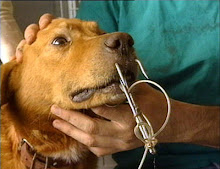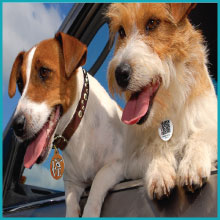Car Safety Restraints For Dogs Found Potentially Unsafe in Pilot Study from the Center for Pet Safety
A pilot study conducted by the Center for Pet Safety has shown that pet safety restraints used in cars may be unsafe, leaving the animals to become projectiles, possibly causing severe injury or death to the animal and potential injury to human family members if an accident occurs. The Center for Pet Safety is located in Haymarket, Virginia, just outside Washington, DC.
A pilot study conducted by the Center for Pet Safetyhas shown that pet safety restraints used in cars may be unsafe, leaving the animals to become projectiles, possibly causing severe injury or death to the animal and potential injury to human family members if an accident occurs. The Center for Pet Safety is located in Haymarket, Virginia, just outside Washington, DC.
The Center for Pet Safety is a 501(c)(3) nonprofit organization which is undertaking a study to define safe travel for companion animals and their owners in a moving vehicle. Currently, animal restraints are not held to specific safety standards and testing by the manufacturer is not a requirement.
Through scientific testing, data collection, and analysis, the Center for Pet Safety plans to author studies of specific types of pet travel “safety” devices and from those studies to develop criteria and test protocols to support safe performance. The Center for Pet Safety is an independent organization, not associated with any pet product manufacturer. The Center is currently seeking grant funding to continue its independent research.
"With tens of millions of dogs traveling with their families every year, the use of pet travel safety restraints is at an all-time high," says Lindsey Wolko, founder and chairman of the Center for Pet Safety. "Safety advocates, travel associations and now law enforcement agencies are recommending ormandating the use of pet safety restraints. But how does the consumer know that the pet harnesses and crates actually protect their pet in the case of an accident? There are currently no official standards to measure performance success, nor are manufacturers required to test their products for this category of pet product. So who says 'safe' is safe?"
While Wolko agrees that tethering or containing your pet may help reduce incidents of distracted driving, any other safety claims must be proven through the development of performance criteria and test methodologies. "Saying that these products prevent your pet from becoming a projectile in an accident is a potentially misleading statement. In our pilot study, the harnesses tested failed to keep the dog from becoming a projectile in a standardized crash simulation."
The pilot study conducted by the Center for Pet Safety in 2011 indicated a 100% failure rate of a set of four popular animal travel harnesses crash tested according to the conditions of Federal Motor Vehicle Safety Standard 213 for child safety seats. FMVSS 213 was selected as it is commonly referenced by some pet product manufacturers and pet safety advocates as a general standard.
The harness size selection for the CPS pilot study was based on the American Kennel Club’s Most Popular Dog Breed List from 2010, where six of the top ten dog breeds were within the “large” harness category. A realistic crash test dog was specially designed, weighted and instrumented for data collection.
In 2011 Lindsey Wolko, pet safety advocate and founder of The Center for Pet Safety, invested over $10,000.00 in scientific testing of pet harnesses used in automobile travel. A “blind” control group of pet travel harnesses was selected for the pilot study. Wolko hired an independent test laboratory, MGA Research Corporation in Manassas, Virginia, to perform unbiased scientific product testing.
MGA Research Corporation performs safety compliance testing for FMVSS 213 child restraint systems for the U.S. Department of Transportation National Highway Traffic Safety Administration.
The goal of the testing was to determine if the products protected the companion animal from injury in a standardized crash simulation. A second round of quasi-static testing was completed to confirm the initial dynamic test results. A weighted and instrumented crash test dog was developed for the tests. No live animals were used for the tests.
Procedures for the testing of companion animal restraints:
A total of 12 restraints from major brands within the pet product industry were purchased from online vendor/manufacturer websites and delivered by independent carrier (UPS, USPS,etc) to the test laboratory. The restraints were received in new, unused condition with intact packaging. The restraints were handled only by laboratory personnel. Out of an initial sampling of 12 brands, four harnesses were selected as a "control group". Selection of the control group was based on perceived strength of the materials and design, associated marketing materials that indicated testing had been completed by the manufacturer and the reputation of the manufacturer in the pet travel product marketplace – similar to the way the consumer would select a product for purchase. Although not identified in the study, the control group harnesses are considered quality brands within the pet product industry and are widely marketed as safety devices for companion animal travel.
A total of 12 restraints from major brands within the pet product industry were purchased from online vendor/manufacturer websites and delivered by independent carrier (UPS, USPS,etc) to the test laboratory. The restraints were received in new, unused condition with intact packaging. The restraints were handled only by laboratory personnel. Out of an initial sampling of 12 brands, four harnesses were selected as a "control group". Selection of the control group was based on perceived strength of the materials and design, associated marketing materials that indicated testing had been completed by the manufacturer and the reputation of the manufacturer in the pet travel product marketplace – similar to the way the consumer would select a product for purchase. Although not identified in the study, the control group harnesses are considered quality brands within the pet product industry and are widely marketed as safety devices for companion animal travel.
"We have re-sampled these products and performed follow-up testing to confirm our initial findings," says Wolko. "While we did not test all brands of harnesses in our initial pilot study, our sampling was broad enough for us to gain better insight regarding the expected performance of these products when tested to Federal Motor Vehicle Safety Standard 213 conditions. Their safety is not guaranteed and the buyer should beware."
About the Center for Pet Safety:
The Center for Pet Safety was founded in 2011 and is a registered 501(c)3 research organization dedicated to companion animal and consumer safety. The idea for the Center for Pet Safety was developed from eight years of pet product industry and consumer research.
The Center for Pet Safety was founded in 2011 and is a registered 501(c)3 research organization dedicated to companion animal and consumer safety. The idea for the Center for Pet Safety was developed from eight years of pet product industry and consumer research.
In 2004 Lindsey Wolko’s dog, Maggie, was injured by a poorly designed safety harness designed for car travel. At that time, Wolko began to purchase pet travel products and try them with her dogs. This practice continued until she launched Canine Commuter in 2007.
Through Canine Commuter, Wolko independently sampled and tested pet products for quality and performance. She purchased the products, ran them through consumer trials, and evaluated them for wear and tear, instructions, marketing, packaging and overall product performance. Over time, Wolko developed official product reports and a formal Consumer Trial Methodology. Products were given a rating based on their overall performance. The products that passed were included on Canine Commuter’s website. Products that failed were put on an unpublished “Watch” list – for follow-up with the manufacturer and future re-evaluation if product improvements were made.
In 2010, Canine Commuter was contacted repeatedly by new pet product manufacturers to lend their product expertise to evaluate proposed product lines and provide feedback. This testing was formalized with the incorporation of the Center of Pet Safety in July 2011 and its recognition by the Internal Revenue Service as a 501(c)(3) non-profit organization. The Center for Pet Safety is currently seeking grant funding to continue its independent research. Donations may be made through The Center for Pet Safety’s websitehttp://www.centerforpetsafety.org/donate-today/.
For more information on the Center for Pet Safety, visit http://www.centerforpetsafety.org.




1 comment:
Same here, I always put them on safty first.
Post a Comment